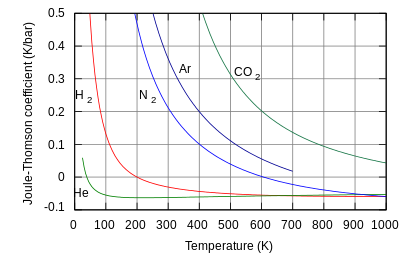Hello Billy T
I have forgotton more about carnot than you have ever learnt. ...Cheers Peter
So you must also have a Ph.D in physics too. From what university? Mine is from The Johns Hopkins university with alumni number 32154 so you can check.
Give yours so I can check. (They will not tell anything about you other than your name. - This is how firms can check claimed degrees.)
Surely you can also prove why no other cycle can be better than the Carnot cycle, as I can. You need not give the proof - just out line the approach in two or three lines.
I know your full of BS and spouting ignorant false physic in your posts. For most recent example, you claim "Helium like CO2 is also a refrigerant."
I.e. you claim He is cools as it expands in a refrigerator in post 2833, quoted below graph below. Well the physical fact is that both H2 & He get
hotter as they expand thru the throttling value refrigerators use as even dry ice temperature is far above the Joule-Tompson inversion temperature, which for He is about 40 degree K or ~233 degrees (C or K) below H2O ice temperatures, which the refrigerators make! See graph below and read this text:
http://en.wikipedia.org/wiki/Joule%E2%80%93Thomson_effect said:
".. Joule–Thomson expansion describes the temperature change of a gas or liquid when it is forced through a valve or porous plug while kept insulated so that no heat is exchanged with the environment.[1][2][3] This procedure is called a throttling process or Joule–Thomson process.[4] At room temperature, all gases except hydrogen, helium and neon cool upon expansion by the Joule–Thomson process... "
Note He is negative for temperatures above ~40K and very different from CO2.
Here is your most recent of many false physics "facts" you have posted:
{post 2833 in part} ... Helium like CO2 is also a refrigerant. Cooling is completed either by radiator as seen at back of a fridge or by expansion chamber as found inside all fridges. Cheers Peter
BTW, it was little trouble for me to quickly find these things
to rub your nose in the horse shit you post as I already knew these facts and their names for quick look-up in Wiki etc.

